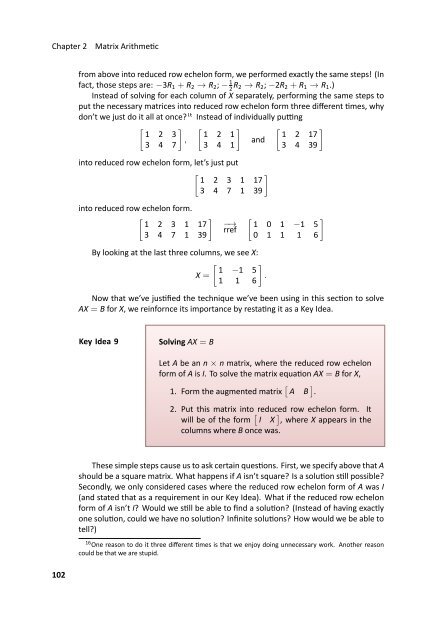Fundamentals of Matrix Algebra, 2011a
Fundamentals of Matrix Algebra, 2011a
Fundamentals of Matrix Algebra, 2011a
You also want an ePaper? Increase the reach of your titles
YUMPU automatically turns print PDFs into web optimized ePapers that Google loves.
Chapter 2<br />
<strong>Matrix</strong> Arithmec<br />
from above into reduced row echelon form, we performed exactly the same steps! (In<br />
fact, those steps are: −3R 1 + R 2 → R 2 ; − 1 2 R 2 → R 2 ; −2R 2 + R 1 → R 1 .)<br />
Instead <strong>of</strong> solving for each column <strong>of</strong> X separately, performing the same steps to<br />
put the necessary matrices into reduced row echelon form three different mes, why<br />
don’t we just do it all at once? 16 Instead <strong>of</strong> individually pung<br />
[ 1 2 3<br />
3 4 7<br />
]<br />
,<br />
[ 1 2 1<br />
3 4 1<br />
]<br />
and<br />
into reduced row echelon form, let’s just put<br />
[ 1 2 3 1<br />
] 17<br />
3 4 7 1 39<br />
[ 1 2 17<br />
3 4 39<br />
]<br />
into reduced row echelon form.<br />
[ 1 2 3 1<br />
] 17<br />
3 4 7 1 39<br />
−→<br />
rref<br />
[ 1 0 1 −1<br />
] 5<br />
0 1 1 1 6<br />
By looking at the last three columns, we see X:<br />
[ ]<br />
1 −1 5<br />
X =<br />
.<br />
1 1 6<br />
Now that we’ve jusfied the technique we’ve been using in this secon to solve<br />
AX = B for X, we reinfornce its importance by restang it as a Key Idea.<br />
. Key Idea 9 Solving AX = B<br />
Let A be an n × n matrix, where the reduced row echelon<br />
form <strong>of</strong> A is I. To solve the matrix equaon AX = B for X,<br />
.<br />
1. Form the augmented matrix [ A B ] .<br />
2. Put this matrix into reduced row echelon form. It<br />
will be <strong>of</strong> the form [ I X ] , where X appears in the<br />
columns where B once was.<br />
These simple steps cause us to ask certain quesons. First, we specify above that A<br />
should be a square matrix. What happens if A isn’t square? Is a soluon sll possible?<br />
Secondly, we only considered cases where the reduced row echelon form <strong>of</strong> A was I<br />
(and stated that as a requirement in our Key Idea). What if the reduced row echelon<br />
form <strong>of</strong> A isn’t I? Would we sll be able to find a soluon? (Instead <strong>of</strong> having exactly<br />
one soluon, could we have no soluon? Infinite soluons? How would we be able to<br />
tell?)<br />
16 One reason to do it three different mes is that we enjoy doing unnecessary work. Another reason<br />
could be that we are stupid.<br />
102

















